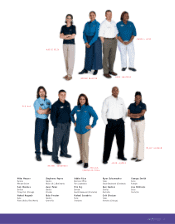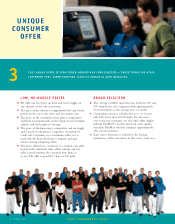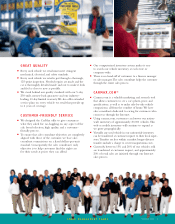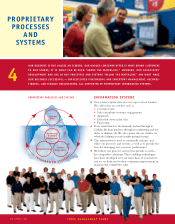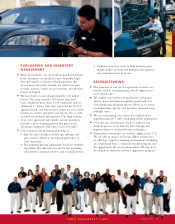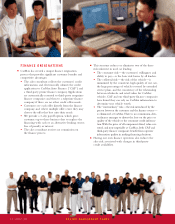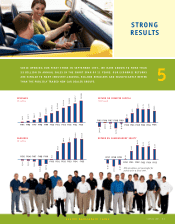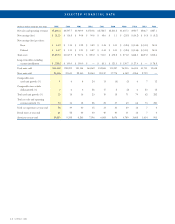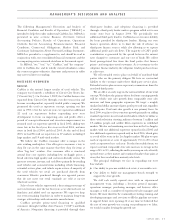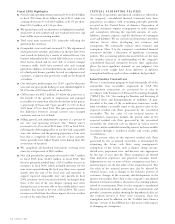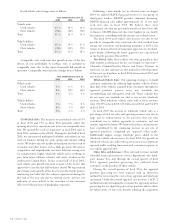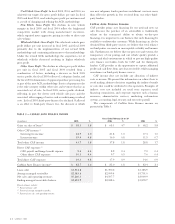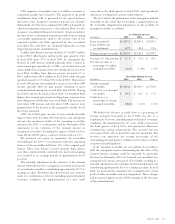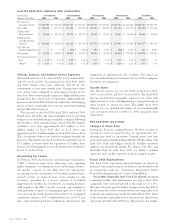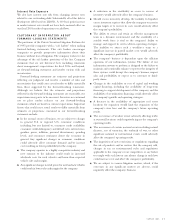CarMax 2005 Annual Report Download - page 19
Download and view the complete annual report
Please find page 19 of the 2005 CarMax annual report below. You can navigate through the pages in the report by either clicking on the pages listed below, or by using the keyword search tool below to find specific information within the annual report.
MANAGEMENT’S DISCUSSION AND ANALYSIS
CARMAX 2005
17
The following Management’s Discussion and Analysis of
Financial Condition and Results of Operations (“MD&A”) is
intended to help the reader understand CarMax, Inc. MD&A is
presented in nine sections: Business Overview; Critical
Accounting Policies; Results of Operations; Operations
Outlook; Recent Accounting Pronouncements; Financial
Condition; Contractual Obligations; Market Risk; and
Cautionary Information About Forward-Looking Statements.
MD&A is provided as a supplement to, and should be read in
conjunction with, our consolidated financial statements and the
accompanying notes contained elsewhere in this annual report.
In MD&A,“we,”“our,” “us,”“CarMax,” and “the company”
refer to CarMax, Inc. and its wholly owned subsidiaries, unless
the context requires otherwise. Amounts and percents in tables
may not total due to rounding.
BUSINESS OVERVIEW
General
CarMax is the nation’s largest retailer of used vehicles. The
company was formerly a subsidiary of Circuit City Stores, Inc.
(“Circuit City”). On October 1, 2002, the CarMax business was
separated from Circuit City through a tax-free transaction and
became an independent, separately traded public company. We
pioneered the used car superstore concept, opening our first
store in 1993. Over the next six years, we opened an additional
32 used car superstores before suspending new store
development to focus on improving sales and profits. After a
period of concept refinement and execution improvement, we
resumed used car superstore growth in fiscal 2002, adding two
stores late in the fiscal year, five stores in fiscal 2003, and nine
stores in both fiscal 2004 and fiscal 2005. At the end of fiscal
2005, we had 58 used car superstores in 27 markets, including 8
large markets and 19 mid-sized markets.
We believe the CarMax consumer offer is unique in the
auto retailing marketplace. Our offer gives consumers a way to
shop for cars in the same manner that they shop for items at
other “big box” retailers. Our consumer offer is structured
around four core equities, including low, no-haggle prices; a
broad selection; high quality; and customer-friendly service. We
generate revenues, income, and cash flows primarily by retailing
used vehicles and associated items including vehicle financing,
extended service plans, and vehicle repair service. A majority of
the used vehicles we retail are purchased directly from
consumers. Vehicles purchased through our appraisal process
that do not meet our retail standards are sold at on-site
wholesale auctions.
Sales of new vehicles represented a decreasing percentage of
our total revenues over the last four years as we divested new car
franchises and added used car superstores. We expect to keep
our seven remaining franchises in order to maintain long-term
strategic relationships with automotive manufacturers.
CarMax provides prime-rated financing to qualified
customers through CarMax Auto Finance (“CAF”) and Bank
of America. Nonprime financing is provided through three
third-party lenders, and subprime financing is provided
through a third-party lender under a program rolled out to our
entire store base in August 2004. We periodically test
additional third-party lenders. CarMax has no recourse liability
for loans provided by third-party lenders. Having our own
finance operation allows us to limit the risk of reliance on
third-party finance sources, while also allowing us to capture
additional profit and cash flows. The majority of CAF’s profit
contribution is generated by the spread between the interest
rates charged to customers and our cost of funds. We collect
fixed, prenegotiated fees from the third parties that finance
prime- and nonprime-rated customers. As is customary in the
subprime finance industry, the subprime lender purchases loans
at a discount.
We sell extended service plans on behalf of unrelated third
parties who are the primary obligors. We have no contractual
liability to the customer under these third-party service plans.
Extended service plan revenue represents commissions from the
unrelated third parties.
We are still at an early stage in the national rollout of our retail
concept. We believe the primary driver for future earnings growth
will be vehicle unit sales growth from comparable store sales
increases and from geographic expansion. We target a roughly
similar fixed dollar amount of gross profit per used unit, regardless
of retail price. Used unit sales growth is our primary focus. In
fiscal 2006, we plan to focus our store growth primarily on adding
standard superstores in new mid-sized markets, which we define as
those with television viewing audiences between 1 million and
2.5 million people, and satellite fill-in superstores in established
markets. We also are broadening our store base in the Los Angeles
market, with one additional superstore opened in fiscal 2005 and
two additional superstores opened early in fiscal 2006, which gives
us a total of five stores in the Los Angeles market. We plan to open
used car superstores at a rate of approximately 15% to 20% of our
used car superstore base each year. For the foreseeable future, we
expect used unit comparable store sales increases to average in the
range of 4% to 8%, reflecting the multi-year ramp in sales of newly
opened stores as they mature and continued market share gains at
stores that have reached base maturity sales levels.
The principal challenges we face in expanding our store
base include:
3Our ability to procure suitable real estate at reasonable costs.
3Our ability to build our management bench strength to
support the store growth.
We staff each newly opened store with an experienced
management team, including a location general manager,
operations manager, purchasing manager, and business office
manager, as well as a number of experienced sales managers and
buyers. We must therefore be continually recruiting, training, and
developing managers and associates to fill the pipeline necessary
to support future store openings. If at any time we believed that
the rate of store growth was causing our performance to falter,
we would consider slowing the growth rate.


